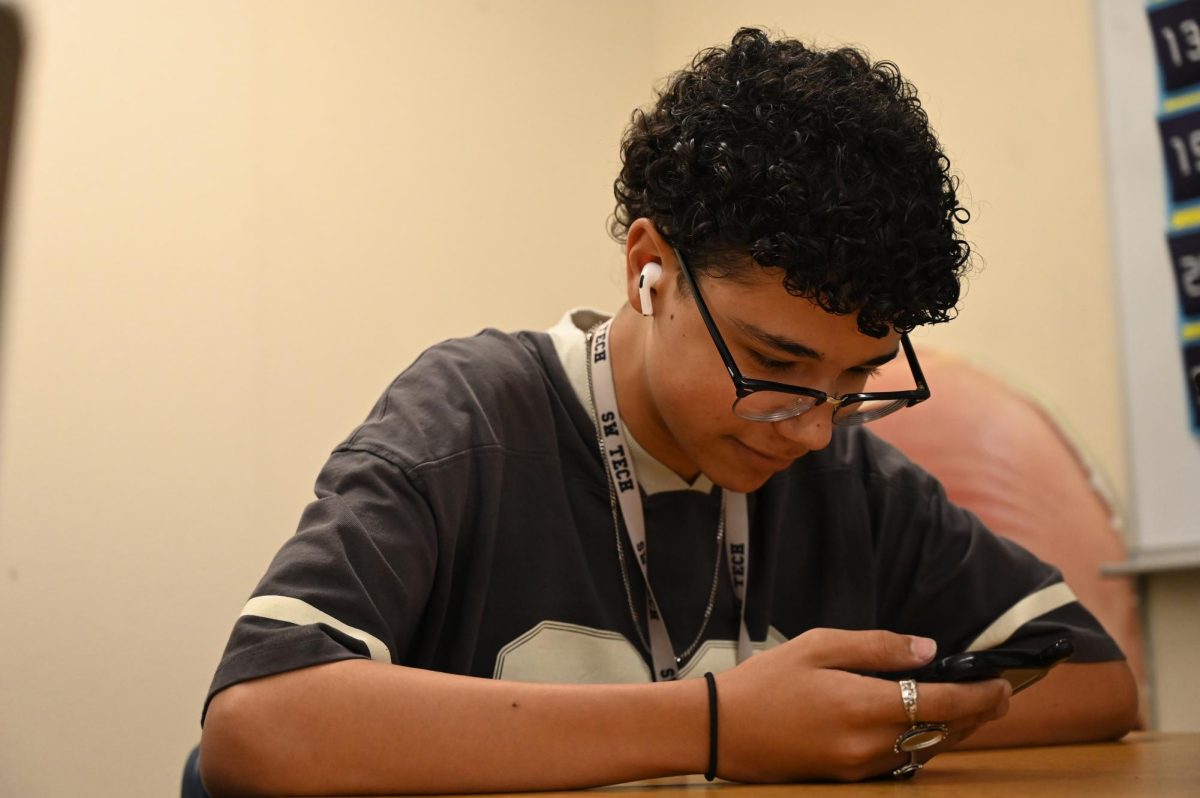Over time, the rise of apps like TikTok, Instagram and YouTube has made it easier than ever to fall into the cycle of doomscrolling, especially during the COVID-19 pandemic when many relied on constant updates of the virus. A study published in Computers in Human Behavior Reports found that this behavior, once viewed as a coping mechanism, is now linked to heightened stress, poor sleep and long-term mental health effects.
The research also found that doomscrolling—excessive consumption of negative news—is associated with feelings of existential anxiety, distrust, suspicion and despair. The study suggests that constant exposure to negative news can serve as a source of indirect trauma, challenging individuals’ beliefs about mortality and control over their lives.
“You just keep going,” junior Jordan Ronsairo said. “You don’t stop. You have to get as much information as you can. It’s like extra studying, as long as you get the right information.”
Meanwhile, Mayo Clinic research emphasizes the emotional toll of consuming disturbing content online. Endless scrolling can trap users in an anxiety-driven loop as algorithms push more negative material, such as updates about global conflicts, climate disasters, mass shootings, or political unrest– all of which amplify feelings of distress, anger, or helplessness. The more time people spend on this content, the stronger the negative emotional effects.
“Anxiety is triggered due to doomscrolling releasing cortisol and adrenaline,” Psychology 101 Teacher Benjamin LaCombe said. “Both are good when used in natural stressful situations, but having too much and constantly is not good for a human being, especially a still growing and developing human being such as a teen. Depression is triggered by constantly having that ‘feeling of missing out,’ negative content and feeling of inadequacy. These feelings get worse the more we use social media and yet we feel that we need to consume even more because we feel as if it’s an escape from our normal lives. It’s just a vicious never-ending cycle.”
In addition, psychologists at the Cleveland Clinic note that doomscrolling can reinforce harmful thought patterns. Users may start scrolling to stay informed or seek validation, but the content they encounter—often negative or sensational—can trap them in a cycle that worsens stress, anxiety and overall mental health.
“It’s usually not a good idea to seek external validation, especially with social media,” senior Evey Kim said. “The videos that people watch give them instant gratification, or posts that could quickly fuel the user’s negative thoughts or reasoning. The algorithm caters to what people interact with and [in] this case it could be other people’s lives [online]. While I think there is nothing wrong with [the algorithm] perse, some people use it [social media] to compare themselves [to the videos they watch], or they could stumble into posts that align with their negative thoughts.”
Furthermore, Harvard Medical School experts also note that sleep is often the first area affected by late-night doomscrolling. Many also use doomscrolling to escape reality and use the content to gain short-term dopamine, which helps with stress. However, this often leads to individuals staying up past their bedtime to chase the effects of gratification, which worsens mood and tolerance the next day.
“Teens are still children, as much as they would like to deny it and sleep is a very important element to a maturing healthy brain,” LaCombe said. “Unfortunately, doomscrolling is causing our ‘children’ to not get enough sleep because we are spending hours before bed consuming social media. Teens are falling asleep with phones in their hands with the screens on when they should be getting eight to ten hours of sleep.”
Consequently, research from The National Institute of Health warns that doomscrolling can increase feelings of helplessness, particularly among young people. This sense of powerlessness can spill into daily life, leaving students struggling to focus in class, falling behind on assignments and seeing their grades slip as stress takes over.
“I find myself doomscrolling when I feel unmotivated,” sophomore Avery Calaunan said. “It makes me feel like I’m running on autopilot, like I’m not interacting with the world around me. I’m just stuck on the screen. One scroll and it’s a new video, so it overstimulates my brain and it’s hard to stop.”
To counteract doomscrolling, studies from Cleveland Clinic suggest people can manage doomscrolling by setting digital boundaries and limiting device use. They note that reducing reliance on devices may help users regain control over their attention.
“[I would say] just set a limit,” Ronsairo said. “You got to look at the time. I noticed that when you start to doomscroll, especially on a phone, the time disappears. You just have to be aware of your surroundings and your time.”



![Grabbing her phone to take a photo, sophomore Vanessa Ta sits down on a bed and takes a couple photos to post on her social media. “I just really [feel] that my favorite cosplayer is everyone lowkey, because I get to see people’s creativity,” Ta said. “I get to see how skilled and talented they are.”](https://southwestshadow.com/wp-content/uploads/2025/10/55A1FC60-BE63-4F24-9B78-65194336319E-e1760926431267.jpg)
![In his fifth period World History class, Thur works with his students individually, helping them as they sort through notes and assorted historical documents. “I’m always willing to try something new,” Thur said. “Some of my best ideas that I’ve received over the years are from students. This year I’m trying out stations for the first time and kids are rotating through and it’s working. Well, some things are [working], I’ve still got to work out the kinks with it. The kids change, why shouldn’t I change too?”](https://southwestshadow.com/wp-content/uploads/2025/10/IMG_8991-1200x800.jpg)
![Fast food has not stayed the same principle of “sit down, order, and get food,” but has turned into a process with multiple layers and complexity. This is largely due to the integration of automation in every aspect of dining. “I'm not that knowledgeable on it, but I've seen videos on TikTok, I'm not really concerned—it doesn’t seem that smart,” senior Dallas Evertt said. “When [some people are just ordering] 18,000 water cups, it sounds really dumb. There was no way [the AI] was gonna put down 18,000 water cups—and that just shows how it’s not going to take anybody’s job soon.”](https://southwestshadow.com/wp-content/uploads/2025/10/Dominante-Image-1200x675.png)
![Squaring up to a practice dummy, sophomore Cypher Andres prepares to throw a punch. Dummies are regularly used to help him prepare certain hits to take his opponents down. “[Boxing dummies help me practice] because it’s basically a model of the body,” Andres said. “It helps with accuracy, such as pressure points behind the ear, and a clean liver shot can end the fight.”](https://southwestshadow.com/wp-content/uploads/2025/10/IMG_5728-e1759850486200-1200x864.jpg)
![Swaying and preparing to toss the tennis ball, Dylan Grove practices serving. Grove had been training in preparation for her upcoming matches against Chaparral and Doral Red Rock. “[Both teams are] both very tough opponents, but I am ready for whatever gets thrown my way,” Grove said.](https://southwestshadow.com/wp-content/uploads/2025/10/image-1200x900.png)